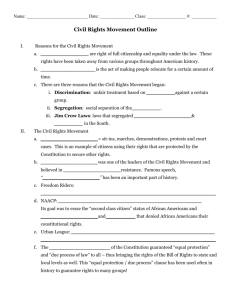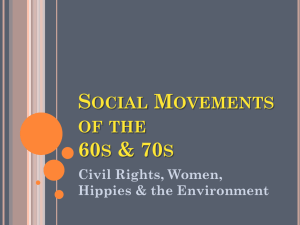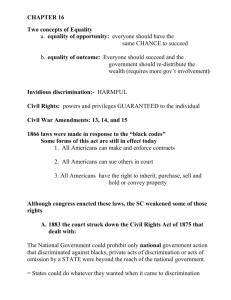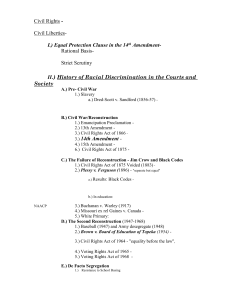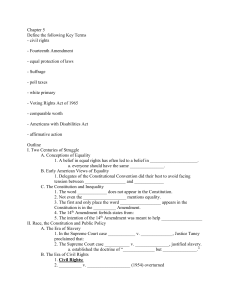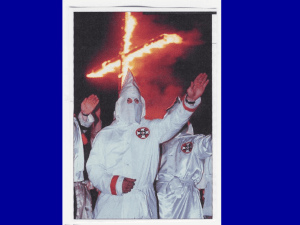Civil Rights Worksheet: AP Government Chapter 5
advertisement
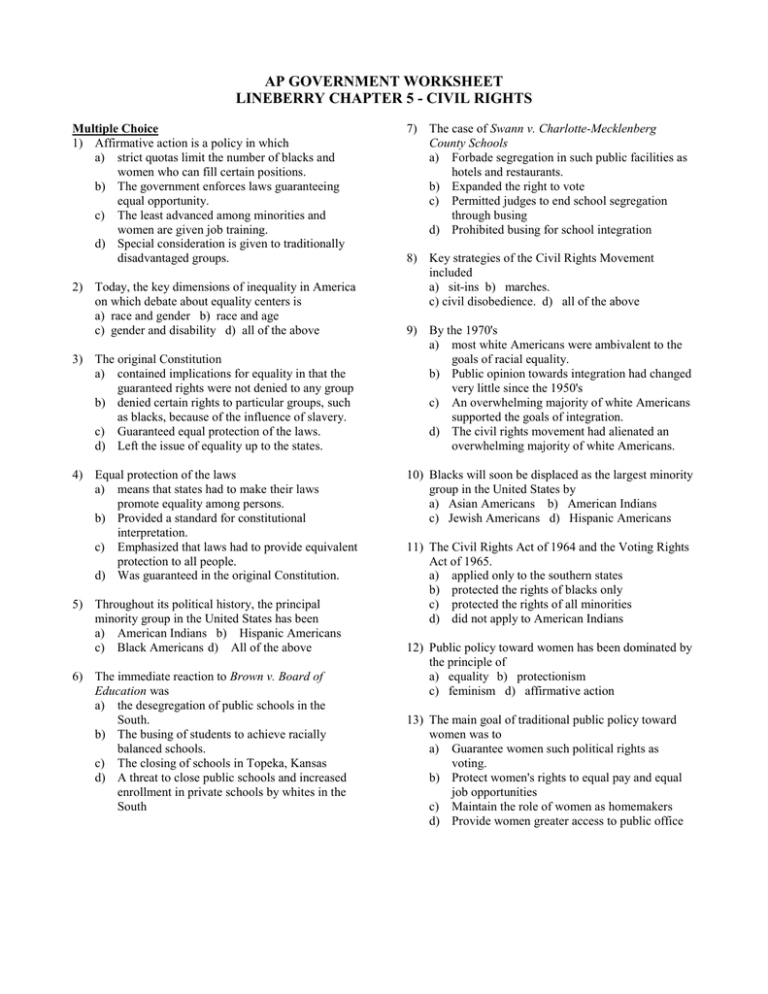
AP GOVERNMENT WORKSHEET LINEBERRY CHAPTER 5 - CIVIL RIGHTS Multiple Choice 1) Affirmative action is a policy in which a) strict quotas limit the number of blacks and women who can fill certain positions. b) The government enforces laws guaranteeing equal opportunity. c) The least advanced among minorities and women are given job training. d) Special consideration is given to traditionally disadvantaged groups. 2) Today, the key dimensions of inequality in America on which debate about equality centers is a) race and gender b) race and age c) gender and disability d) all of the above 3) The original Constitution a) contained implications for equality in that the guaranteed rights were not denied to any group b) denied certain rights to particular groups, such as blacks, because of the influence of slavery. c) Guaranteed equal protection of the laws. d) Left the issue of equality up to the states. 4) Equal protection of the laws a) means that states had to make their laws promote equality among persons. b) Provided a standard for constitutional interpretation. c) Emphasized that laws had to provide equivalent protection to all people. d) Was guaranteed in the original Constitution. 5) Throughout its political history, the principal minority group in the United States has been a) American Indians b) Hispanic Americans c) Black Americans d) All of the above 6) The immediate reaction to Brown v. Board of Education was a) the desegregation of public schools in the South. b) The busing of students to achieve racially balanced schools. c) The closing of schools in Topeka, Kansas d) A threat to close public schools and increased enrollment in private schools by whites in the South 7) The case of Swann v. Charlotte-Mecklenberg County Schools a) Forbade segregation in such public facilities as hotels and restaurants. b) Expanded the right to vote c) Permitted judges to end school segregation through busing d) Prohibited busing for school integration 8) Key strategies of the Civil Rights Movement included a) sit-ins b) marches. c) civil disobedience. d) all of the above 9) By the 1970's a) most white Americans were ambivalent to the goals of racial equality. b) Public opinion towards integration had changed very little since the 1950's c) An overwhelming majority of white Americans supported the goals of integration. d) The civil rights movement had alienated an overwhelming majority of white Americans. 10) Blacks will soon be displaced as the largest minority group in the United States by a) Asian Americans b) American Indians c) Jewish Americans d) Hispanic Americans 11) The Civil Rights Act of 1964 and the Voting Rights Act of 1965. a) applied only to the southern states b) protected the rights of blacks only c) protected the rights of all minorities d) did not apply to American Indians 12) Public policy toward women has been dominated by the principle of a) equality b) protectionism c) feminism d) affirmative action 13) The main goal of traditional public policy toward women was to a) Guarantee women such political rights as voting. b) Protect women's rights to equal pay and equal job opportunities c) Maintain the role of women as homemakers d) Provide women greater access to public office 14) The conflict over the Equal Rights Amendment centered on the issue of whether women should a) be allowed to campaign for public office b) have the right to attend traditionally male schools c) receive equal pay for equal work d) sacrifice traditional protections for the sake of equality 15) 'Comparable worth' refers to the issue of a) equal voting rights and access to public office for women b) paying men and women equivalent salaries for jobs requiring similar skills c) government subsidization of women who choose to work at home d) all of the above 16) The Civil Rights and Women's Equity in Employment Act of 1991 a) banned sex discrimination in employment b) forbade sex discrimination in federally subsidized education programs c) shifted the burden of proof in justifying hiring and promotion practices to employers d) made it illegal for employers to exclude pregnancy and childbirth from their healthbenefits plans 17) Which of the following was not an effect of the Voting Rights Act of 1965? a) the registration of many southern black voters b) the use of white primaries c) the election of more black officials d) the intervention of federal election registrars 18) The Americans with Disabilities Act of 1990 a) strengthened previous protections against discrimination against the disabled b) required employers and public facilities to make reasonable accommodations c) prohibited employment discrimination against the disabled d) all of the above 19) The Supreme Court held that an admissions quota for particular groups were illegal in a) United Steelworkers of America, AFL-CIO v Weber b) Fullilove v Klutznick c) Regents of the University of California v Bakke d) Wygart v Jackson Board of Education 20) Opposition to affirmative action is especially strong when people view it as a) affecting only African Americans b) a form of separate-but-equal c) reverse discrimination d) discriminating against women True or False: There are FOUR false statements 21) Neither the word "equality" nor the idea of equality appears in the original Constitution. 22) The only reference to the idea of equality in the entire constitution are the words "equal protection of the laws." 23) The era of racial segregation began to end at the turn of the century after Plessy v Ferguson. 24) Brown v Board of Education brought a rapid end to school segregation in the south. 25) The civil rights movement began in 1955 when Rosa Parks refused to give up her seat on a bus to a white man. 26) The 1954 Brown v Board of Education case was the beginning of a string of Supreme Court decisions holding various forms of discrimination unconstitutional. 27) To exclude blacks from voting, most southern states required a poll tax levied on the right to vote. 28) The Voting Rights Act of 1965 had very little impact on politics in the South as most blacks were apathetic about voting. 29) American Indians did not become citizens of the US until 1924. 30) The only part of the population which has no constitutional protection against discrimination is white males under the age of 40. 31) A college admissions policy in which students were selected strictly on the basis of merit is an example of affirmative action. FILL IN 32) In __________________________________________, the Court ruled that federal programs that classify people by race are constitutional only if they are "narrowly tailored" to accomplish a "compelling governmental interest." 33) ___________________ is the name for policies that give special consideration to traditionally disadvantaged groups to make up for past discrimination. 34) The boldest Supreme court decision in defense of slavery was __________________________. 35) ____________________________ consists of public policies and social customs requiring the separation of specific groups in schools, housing and other activities. 36) In __________________________________________, the Supreme Court upheld the right of judges to order school busing in both north and south. 37) The ________________________________ made racial discrimination against any group in hotels, motels, and restaurants illegal. 38) In the early Republic, ____________________ was limited to a handful of the population, mostly property-holding white males. 39) In states requiring a literacy test of all prospective voters, the _______________________________ exempted people whose grandfathers were eligible to vote in 1860. 40) In _________________________________ the Supreme Court upheld the internment of Japanese Americans during WWII as constitutional. 41) The ________________________ guarantees women the right to vote. 42) The ________________________ was a proposed addition to the Constitution that said "equality of rights under the law shall not be denied or abridged by the US or by an state on account of sex." 43) __________________________ is the view that women's work is just as valuable as men's work and should be equally compensated. 44) _______________________ and _______________________ are two recent entrants in the civil rights policy game. 45) ___________________________ required employers and public facilities to make reasonable accommodations and prohibited employment discrimination against the disabled. Chapter 5 - Civil Rights 1)D 2)D 3)A 4)C 15)B 16)C 17)B 18)D 5)C 19)C 6)D 20)C 7)C False statements - 23, 24, 28, 31 32) AdarandvPena 33) Affirm. Action 34) Dred Scott 35) Segregation 36) Swann v Char. 37) Civil RtsAct ‘64 38) suffrage 39) grandfather clause 40) Korematsu v US 41) 19th Amend. 42) Equal Rights Amendment 43) Comparable worth 44) older Americans and the disabled 45) Americans w/Disabilities Act 8)D 9)C 10)D 11)C 12)B 13)C 14)D COMPARE AND CONTRAST 46) Fourteenth Amendment and equal protection of the laws 47) Civil Rights Act of 1964, Americans with Disabilities Act 1990, and Voting Rights Act 1965 48) poll taxes and white primaries 49) Reed v Reed and Craig v Boren 50) affirmative action, Bakke decision, Adarand v Pena 51) de jure segregation and de facto segregation
